Repetitive self-grooming behavior in the BTBR mouse model of autism is blocked by the mGluR5 antagonist MPEP
- PMID: 20032969
- PMCID: PMC2827881
- DOI: 10.1038/npp.2009.201
Repetitive self-grooming behavior in the BTBR mouse model of autism is blocked by the mGluR5 antagonist MPEP
Abstract
Autism is a neurodevelopmental disorder characterized by abnormal reciprocal social interactions, communication deficits, and repetitive behaviors with restricted interests. BTBR T+tf/J (BTBR) is an inbred mouse strain that shows robust behavioral phenotypes with analogies to all three of the diagnostic symptoms of autism, including well-replicated deficits in reciprocal social interactions and social approach, unusual patterns of ultrasonic vocalization, and high levels of repetitive self-grooming. These phenotypes offer straightforward behavioral assays for translational investigations of pharmacological compounds. Two suggested treatments for autism were evaluated in the BTBR mouse model. Methyl-6-phenylethynyl-pyridine (MPEP), an antagonist of the mGluR5 metabotropic glutamate receptor, blocks aberrant phenotypes in the Fmr1 mouse model of Fragile X, a comorbid neurodevelopmental disorder with autistic features. Risperidone has been approved by the United States Food and Drug Administration for the treatment of irritability, tantrums, and self-injurious behavior in autistic individuals. We evaluated the actions of MPEP and risperidone on two BTBR phenotypes, low sociability and high repetitive self-grooming. Open field activity served as an independent control for non-social exploratory activity and motor functions. C57BL/6J (B6), an inbred strain with high sociability and low self-grooming, served as the strain control. MPEP significantly reduced repetitive self-grooming in BTBR, at doses that had no sedating effects on open field activity. Risperidone reduced repetitive self-grooming in BTBR, but only at doses that induced sedation in both strains. No overall improvements in sociability were detected in BTBR after treatment with either MPEP or risperidone. Our findings suggest that antagonists of mGluR5 receptors may have selective therapeutic efficacy in treating repetitive behaviors in autism.
Figures
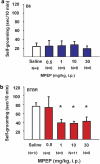
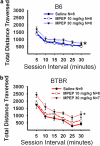


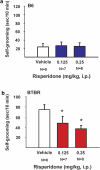
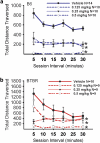
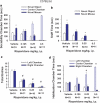

References
-
- Anderson GM, Gutknecht L, Cohen DJ, Brailly-Tabard S, Cohen JH, Ferrari P, et al. Serotonin transporter promoter variants in autism: functional effects and relationship to platelet hyperserotonemia. Mol Psychiatry. 2002;7:831–836. - PubMed
-
- Anderson JJ, Bradbury MJ, Giracello DR, Chapman DF, Holtz G, Roppe J, et al. In vivo receptor occupancy of mGlu5 receptor antagonists using the novel radioligand [3H]3-methoxy-5-(pyridin-2-ylethynyl)pyridine) Eur J Pharmacol. 2003;473:35–40. - PubMed
-
- Barnard L, Young AH, Pearson J, Geddes J, O'Brien G. A systematic review of the use of atypical antipsychotics in autism. J Psychopharmacol. 2002;16:93–101. - PubMed
Publication types
MeSH terms
Substances
Grants and funding
LinkOut - more resources
Full Text Sources
Other Literature Sources
Molecular Biology Databases
Miscellaneous

